- Sport
- Sailing
- Sydney to Hobart
This was published 9 months ago
Bizarre conflict polarises Sydney’s historic 18-foot skiff sailing world
By Emma Kemp
Sean Langman spends almost every waking moment at his boatyard. He has quite the view from Noakes Group at McMahons Point - a long-distance one of the Harbour Bridge and a close-up of Moneypenny.
His 69-footer, which claimed third place overall in the recent Sydney to Hobart, has finally returned for post-race maintenance and is hoisted high among the rest of the recreational and commercial vessels being worked on.
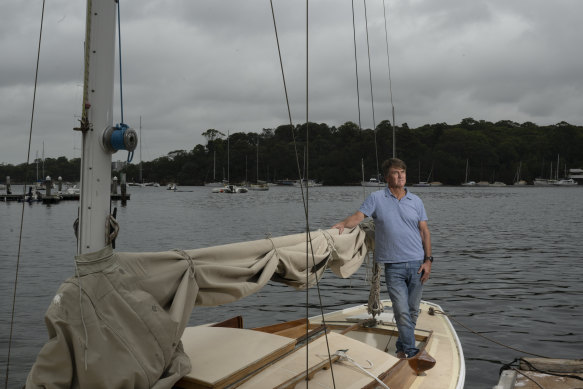
Sean Langman at his Noakes boatyard.Credit: Louise Kennerley
However, while the James Bond-theme yacht he skippered in his 30th blue-water classic is probably his most classically luxurious, his heart lies with the much smaller wooden craft in the shed. Langman gets most attached to these raw babies he moulds into seaworthy beauties. The other that fits that category is Big Pete, an 18-foot skiff named after his late father and the source of an almighty divide in the racing community.
The short version is that Langman has been banned from contesting the upcoming JJ Giltinan International Trophy series – the unofficial annual 18-footer world championship – which begins at the start of March. This is not because the veteran skipper’s boat does not comply with class rules, but because he owns the boat he wishes to sail.
That sounds a little nonsensical until you understand the long version. The Australian 18 Footers League, which runs contemporary 18-footer racing in Sydney, owns all the boats. It says its board designates boats to skippers and crews, and offsets the costs with sponsorship. As part of the sponsorship agreements, the league says each boat must race every weekend.
They are the rules for local boats. International boats are also invited annually to compete in the JJ Giltinan Trophy, but can be privately owned and are not required to compete in Sydney during the season.
Langman has competed regularly in the Sydney 18-footer season in recent decades, sponsoring his own campaigns on league-owned boats, as well as those of others, and supporting young sailors and women through his Noakes Youth and Noakes Blue initiatives respectively.
However, the 62-year-old’s bid to race the ‘JJs’ on Big Pete was knocked back late last year. The reason, according to a December 23 email from league chief executive Warren Sare, is that: “The League has a formula that has worked very well for many years and your request to sail part season and the JJ’s in a privately owned boat was at odds with that formula.”
In an attempt to get around this ban, New Zealand’s Royal Akarana Yacht Club – of which Langman is a member – applied to enter Big Pete as an international with a Kiwi skipper and Langman on the crew. Once more, the entry was rejected.
A part of Langman’s plea was on mental health grounds, having endured a difficult 2023 and turned to sailing as a means of support. In the knowledge he will not be able to compete, he says he will check himself into a mental health clinic later this week for a three-week stay.
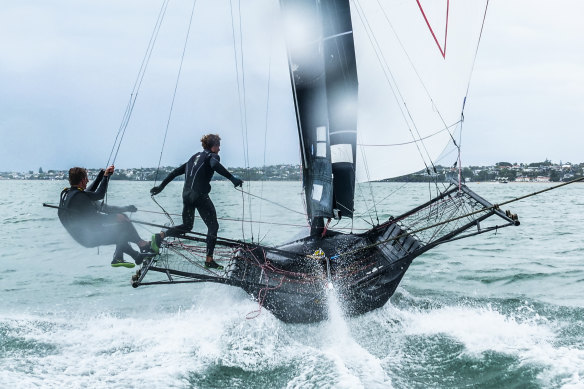
Big Pete in action. Sean Langman says he took “a boat that had stagnated and tried to make it sexy as all get out”.Credit: Suellen Hurling / Live Sail Die
“I did reach out and said, ‘Look, I’m actually not going too well at the moment. I love sailing. Is there any chance I can come for a sail? It would be good for my head’,” Langman says.
“I’ve been in and out of the class for 35 years. The last decade I’ve been there full-time, and sponsoring youth boats and female sailors, etc. We had three boats on the water for the last three years.
“I’m not a threat. It’s not like I’ve trained – the boat’s been in the shed for a year. It wasn’t like I was turning up with an Olympic crew again. I was just turning up to go for a sail, and it was knocked on the head. It’s not the end of the world. It is just that I think their model of inclusiveness needs to have a bit of a look.”
A league of its own
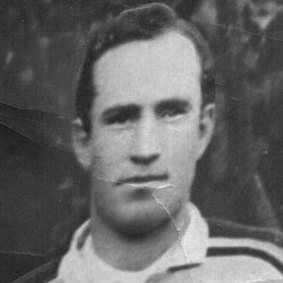
Rugby league great Dally Messenger was also a passionate sailor.
The JJ Giltinan Trophy series is named after James Joseph Giltinan, the Australian entrepreneur heavily involved in introducing rugby league to Australia in the early 1900s. His masterminding of league’s breakaway from rugby union, which included organising meetings with politicians and businessmen, and persuading the great Dally Messenger to switch allegiance, effectively birthed the NRL as we know it today. Each season the JJ Giltinan Shield is awarded to the NRL ’s minor premiers.
In the first half of the 20th century, footy and sailing 18-footers were culturally intertwined. Messenger, for instance, worked at his father’s boat shed and was one of many leaguies who spent their off-seasons down at the waterfront. “What happened was they all sort of had one jumper, and they played football in the winter and went sailing in the summer,” says John Stanley, an Australian yachtsman and acknowledged 18-footer historian.
Back then, they competed out of the Sydney Flying Squadron Yacht Club. The country’s oldest open boat sailing club, which still operates at Kirribilli, was founded in 1891 by department store and Hydro Majestic businessman Mark Foy. “The Squaddy” challenged the sailing conventions of the time by introducing coloured sails and prizemoney, along with a scratch start – all changes designed to make sailing accessible regardless of financial circumstances.
In 1935 Giltinan returned to Sydney’s eastern suburbs, this time to engineer a sailing breakaway to rival the Flying Squadron. He formed the NSW 18 Footers League, now known as the Australian 18 Footers League, and adopted the radical design innovations that had been banned by The Squaddy because they made the boats significantly faster. In 1938, the rebel league staged the inaugural JJ Giltinan Trophy, an international championship which remains the world’s premier 18-footer event.
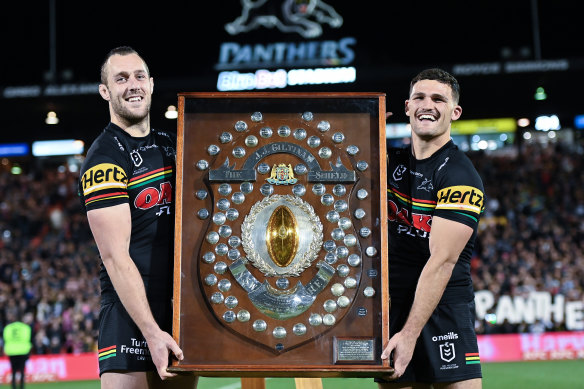
Penrith’s Isaah Yeo and Nathan Cleary with the NRL’s JJ Giltinan Shield last September.Credit: Izhar Khan/Getty Images
If a “big three” exists in 18-foot sailing, then John Winning senior arguably completes the triumvirate. During the 1990s, as the sport’s global popularity waned under the heavy cost of technological one-upmanship, the league introduced a one-design hull (Big Pete is made from that mould) to try and reduce some of the cost, increase its longevity of the hull and make the boats more accessible to more competitors. Winning, the mega-rich Australian appliance retailer and veteran sailor, became president in 2004 and has since been central to its financial stability.
The 71-year-old – the father of 2022 Sydney to Hobart line honours-winning Andoo Comanche skipper and 18-foot sailor John Winning jnr – has helped devise and uphold a set of rules he says double as “sort of our salary cap”.
“We endeavour to get people to commit to the class, and by that the club owns all the boats,” Winning says. “If I want to sail there, the club has to own my boat. Doesn’t matter if I pay for it five times over. We try to keep it affordable. We have sponsors that put money in, and some of them have got more than others. We generally need to spend everything they put in, but then the club will top up the lesser sponsor stuff so that the boats are competitive and all get in there.
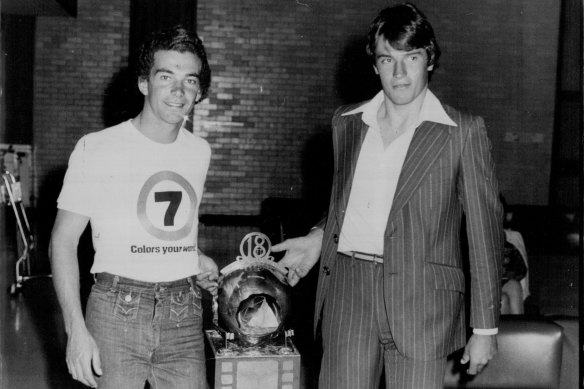
The JJ Giltinan Trophy in the hands of crew member Ian Souter, 24, from North Sydney and skipper Iain Murray after winning the first of six straight with Color 7.Credit: Antony Matheus Linsen
“We’ve got a class because we sail every week. We live stream it. We’ve got a ferry that follows it - Sean [Langman] actually owns the ferry company. But if we don’t sort of nicely make them commit, then we won’t have anyone. So that’s fundamentally why we’ve got rules that say that the club must own the boat that you have to sail every week. That’s the condition, you sign up as a skipper and here’s the boat essentially for nothing with a sponsor. But if you don’t turn up, we get someone else to sail it.
“So personally I’d love to see Sean sailing every week, but I don’t think that would do the class any good to allow him just to turn up and do this, that and the other, because it’s against the rules.”
Rule the waves
The issue with the rules is that they have not been readily found in writing. The league’s 18-foot skiff Class Rules document does not include JJ Giltinan Trophy eligibility requirements. When asked specific questions via email about who decides who is given a boat to sail, and how sponsorship income is received and distributed, Sare directed this masthead to the League’s “public document Joining the Fleet”.
The URL hosting the Joining the Fleet article did not exist in the most recent archived copy of the league’s full website on January 17, 2024. Google’s time stamp on the URL, which specifies when the search engine last “crawled” that web page, is Wednesday afternoon – shortly before the answers were provided via email.
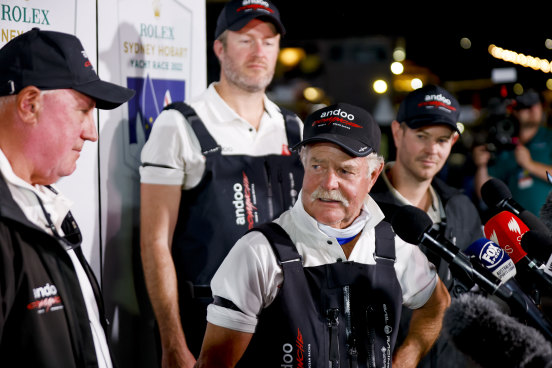
John Winning snr with his son John jnr (background) after Andoo Comanche took 2022 Sydney to Hobart line honours.
After requesting the publish date of the article, Sare said: “The context of the Joining the Fleet document has existed in the Skippers Agreement for many years. The Skippers Agreement is a document that describes the expectations and deliverables by the 18 Footers and the 18 Footer Skipper. Sean Langman is very aware of this document having signed one each year for the seasons he has competed in over the last decade. The Joining the Fleet document is new this year to provide information to potential new crews coming into the 18 Footers.”
Sare says Langman “entered into agreement for the 2022-2023 season to own the boat and understood that would exclude him from future entry based on his commitment to take the boat overseas to race and eventually sell”. Langman says “that’s not true”.
“It was going to Europe, that was pre-COVID,” Langman says. “There was nothing stopping that boat ever, in any contract, for it to come back and sail the JJs again. What I applied for and was agreed by Simon Nearn, the Commodore, is that to take a boat away for a year or two or three or whatever, without it being the league’s asset, had to be owned. I just wanted to do something different, after 10 years of turning up every Sunday. So I ended up in New Zealand and did something different, and then we brought it back.”
Auckland Skiff League fleet manager Graham Catley requested Big Pete’s inclusion via email on December 23. “As you know Sean joined the NZ fleet in 2022, became a member of our club, and shipped his boat to NZ to train and support the post-COVID restart of the NZ 18ft skiff activity,” Catley wrote to Sare. “In fact Sean was instrumental in motivating myself and our potential young 18ft skiff sailors in getting the fleet up and sailing again. His commitment to the young NZ sailors was quite amazing, which I presume is the same as he does for the young sailors in the Sydney fleet.”
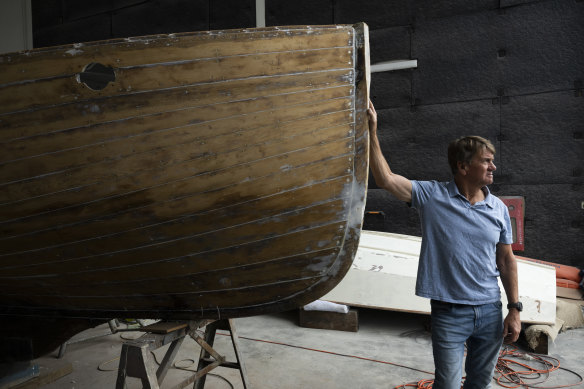
Sean Langman appealed for JJs entry on mental health grounds.Credit: Louise Kennerley
The Australian 18-Footers League says Big Pete was allowed entry last year as it was located in New Zealand for the months leading up to the JJs and had sailed there during that time. This year, however, it reasons that Big Pete has not sailed yet this season, either in NZ or NSW.
Winning listed a string of irritations he had with Langman, and added that his modifications to Big Pete “bent the rules – broke the rules, really” (Langman freely admits he “pushed the interpretations as hard as I can push it”).
Winning says the first he heard Langman “had any mental issues” was Thursday, when somebody alerted him to his Facebook post from Wednesday, which detailed his struggles. He did not believe his long-term dedication to the sport warranted an entry. “Plenty of people have put more into the sport than he has,” Winning says. “Does that let write your own rules? I can’t believe he even asked, after what we did for him last year and everything else. But he’s a trier.”
An external observer, who wished not to be named in order to speak freely, believes the bizarre furore highlights underlying questions about Winning’s perceived monopoly of a class laden with sponsors from the white goods industry.
Langman himself wants the pool to widen. “They’ve had John Winning there for many years, Winning Appliances propping up the club,” he says. “You’ve got to excite some other philanthropists other than just John Winning. If you don’t excite more there, it’s just going to go.”
Stanley thinks Winning has been invaluable for the class but sailing in general is “really struggling”.
“There’s so many other sports out there now,” Stanley says. “The biggest problem with sailing is that over the years they’ve been chasing lightness and speed. So you’ve now got the America’s Cup, which, from when I did it in 1980 and when we won it in ’83, is a whole different ball game completely.
“It’s not even sailing now, it’s flying. The boat’s not even in the water, it’s on two foils and it’s all done with electronics. It’s Formula 1 on the water. Unbelievable money and professionalism, but it’s lost a lot of credibility with the older generation.”
Sports news, results and expert commentary. Sign up for our Sport newsletter.